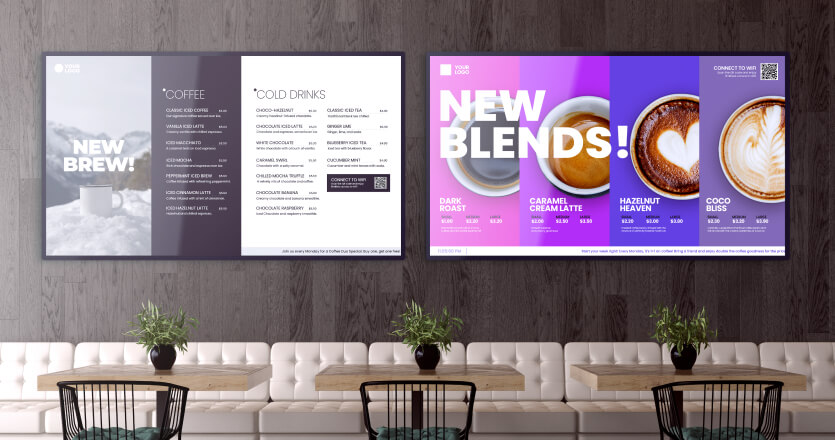Running a business requires a continuous quest for inventive ways to capture and maintain people’s interest. Whether your aim is to increase sales, keep your audience informed about upcoming events, or foster a welcoming atmosphere, digital signage appears as your hidden asset. With its dynamic and adaptable technology, you can effortlessly engage and connect with your audience, enhancing your outreach and interaction.
Indoor Digital Signage: What Is It?
Indoor digital signage refers to the use of electronic displays, such as LCD or LED screens, to deliver information, advertisements, or multimedia content within indoor spaces. Unlike traditional static signs, indoor digital signage offers real-time flexibility and the ability to tailor content to specific audiences or situations.
Use Cases That Shine Bright
Retail
In the fiercely competitive market of retail, attracting and engaging customers can be a particularly difficult task and sometimes overwhelming too. With the use of indoor digital signage, you can effortlessly create engagement and foster a better connection with your customers. For instance, retail digital signage will allow you to showcase promotions, discounts, special offers, or product recommendations in a visually engaging and appealing manner.
Restaurants and Food Services
Indoor digital signage for restaurants, bars and cafes can streamline operations and enhance the overall customer experience. By displaying digital menu boards, you can offer real-time updates on offerings, and mouthwatering images of dishes and accommodate multilingual customers with menu options in different languages.Wayfinding and Informational Displays
Navigating complicated indoor spaces, such as airports, hospitals, or large office buildings, can be a daunting task. With the use of indoor digital signage, you can provide clear and interactive wayfinding digital signage, helping visitors easily locate their destination, check-in for flights, or find the nearest restroom.
Corporate Communication
In the corporate world, effective internal communication is vital for employee engagement and productivity. Indoor digital signage can be an invaluable tool for delivering company announcements, updates, and performance analytics. By strategically placing screens in break rooms, meeting rooms, or common areas, businesses can ensure that important information reaches their employees efficiently.
Hospitality
Hospitality digital signage is used in hotels, resorts, and entertainment venues to enhance the guest experience. From digital concierge services that provide local recommendations to digital menu boards in their restaurants and bars, these digital displays will upgrade the overall atmosphere and streamline operations.
Healthcare
In healthcare facilities, it is vital to provide patients with the right communication and education. You can use indoor digital signage screens to showcase appointment schedules, medical information, and wayfinding instructions. Additionally, waiting rooms can become less daunting with entertaining content, reducing anxiety for patients and their families.
Educational Institutions
Schools and universities will benefit from indoor digital signage, as it can effectively improve campus communication. Announcements, class or event schedules, and emergency alerts can be broadcast quickly and efficiently. Moreover, digital signage can foster a modern and more engaging learning environment through interactive displays and educational content.

Manufacturing
For manufacturing facilities, where efficiency and safety are important, indoor digital signage can be a helpful tool. Displaying real-time production metrics, safety protocols, and workflow instructions on strategically positioned screens accessible to factory workers will ensure they grasp complex procedures and safety guidelines effectively. Additionally, manufacturing digital signage will streamline the process, improve communication among workers, and enhance overall productivity, contributing to a safer and more efficient workplace environment.
Events
Trade shows and events thrive on dynamic presentations and engaging displays. Indoor digital signage for events allows organizers to create immersive brand experiences, provide event schedules on digital calendar displays, and showcase sponsor content, ultimately enhancing attendee engagement and satisfaction. Events and indoor digital signage share a significant bond.
Museums and Galleries
Cultural institutions can use indoor digital signage to bring history and art to life. Visitors can enjoy interactive exhibitions, outstanding audiovisual presentations, or detailed descriptions of artifacts. These displays create a richer and more engaging experience, making museums and galleries more appealing to a diverse audience.
The Power of Content
Even though the hardware and software behind indoor digital signage are vital components, the heart of its effectiveness lies in the displayed content. Engaging and relevant content is the key to capturing viewers’ attention. From eye-catching visuals to concise and informative messages, content should always be carefully created to align with the specific goals of each use case.
Interactive Engagement
One of the most important features of digital signage, especially indoors, is its potential for interactivity. Using touchscreen digital signage displays allows users to interact with your content, whether it’s navigating a wayfinding map or selecting menu items. This interactivity not only enhances the user experience but also provides valuable data on user preferences and behaviors.
Content Management and Updates
To keep content fresh and relevant, a strong content management system (CMS) is essential. A good CMS allows administrators to schedule content updates, monitor displays remotely, and ensure consistent branding across all screens. This flexibility ensures that the right message reaches the right audience at the right time.
Indoor digital signage is more than just some screens on walls; it’s a dynamic communication tool that will easily enhance countless indoor environments, from retail stores and restaurants to corporate offices and healthcare facilities. The applications of this technology are vast and ever-expanding, creating better experiences, improving communication, and ultimately fostering a sense of community among workers and customers in businesses. As this technology continues to evolve, don’t be surprised if it plays an increasingly integral role in shaping indoor spaces.
